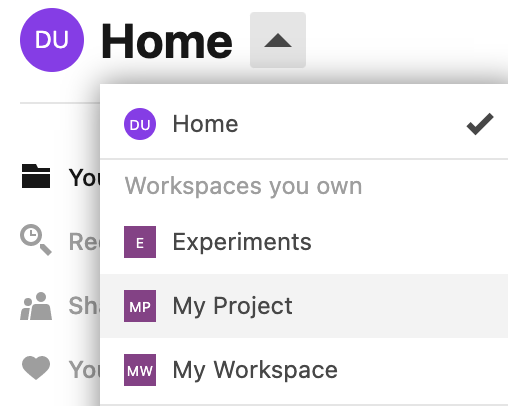Snowflake
This is a general procedure of creating a Snowflake database connection. Follow these instructions to use the interface of the New connection dialog for this particular database type.
Configure an Snowflake connection
Open the New Snowflake connection dialog. Select the tab for one of the two options:
From the editor, to attach the new database to a specific notebook
From the Home page, to add a database connection to a workspace
Go to or click the Attached data icon on the left-hand sidebar.
Click New connection and select New database connection.
In the New database connection dialog, select Snowflake.
On the Home page, select the workspace where you want to create the connection.

Select Databases from the menu under the workspace name.
Click the Add connection button in the upper right corner. The New database connection dialog will open.
In the New database connection dialog, select Snowflake.
On the General tab, select the connection type.
default: to connect by specifying the Host, Port, and Database.
URL only: to connect by providing the URL of a pre-built connection.
(For default) In the Host field, type your server address.
(For default) In the Port field, type the port of BigQuery. The default port is 443.
Select an authentication method:
User & Password: to connect using your login and password.
Authenticator: to connect using the authenticator to verify the user login credentials. For example, to use browser-based SSO for authentication, enter
externalbrowser.For more information about the authenticator, refer to the Snowflake official documentation.
Snowflake OAuth: to connect using the Snowflake OAuth method.
Snowflake with stored tokens: to connect using access and refresh tokens.
No auth: to connect without authentication.
Proceed based on the selected authentication method:
UserPassword
In the User and Password, provide your credentials.
In the Authenticator, provide the authenticator.
Get a client ID and a client secret by following the official instructions. Do the following in the New Snowflake connection dialog:
In the Client ID field, paste your client ID.
In the Client secret field, paste your client secret.
Get a client ID, client secret, and access and refresh tokens by following the official instructions. Do the following in the New Snowflake connection dialog:
In the Client ID field, paste your client ID.
In the Client secret field, paste your client secret.
Click Authenticate and fill tokens.
No special steps are required for this option.
Based on the selected connection type, do the following:
In the Database field, provide the name of the database you want to connect to.
(Optional) In the Schema field, provide the schema you want to access.
(Optional) In the Warehouse field, type the name of a cluster of compute resources in Snowflake you want to use. For more information about warehouses, refer to the Snowflake official documentation.
(Optional) In the Role, provide the database role.
URL
Click the Test connection button at the bottom of the dialog.
Once the connection is successfully tested, click the Save and close button.
Results
If created for a specific notebook, the new connection will be automatically added to the workspace. You can later attach this database to any other notebook from this workspace.
If created for a workspace, this connection is added to the workspace databases and can be attached to any noteboook from this workspace.